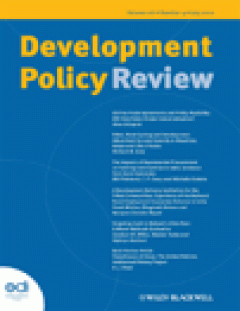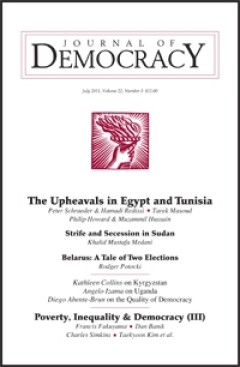Filter by

Impacts of Economic Crises on Child Well-being
This theme issue addresses three research questions: i) how are the impacts of macro-level crises transmitted to children's micro-level experiences of poverty and well-being? ii) in what ways can these impacts be mediated by the policy responses of international and national actors? and iii) what lessons can be derived from responses to past crises and to what extent is this learning being appl…
- Edition
- Volume 29, Issue 5, September 2011, pages 511–526
- ISBN/ISSN
- 09506764
- Collation
- -
- Series Title
- Development Policy Review Special Issue: Impacts of Economic Crises on Child Well-being
- Call Number
- -

Effects of the Global Financial Crisis on Children's School and Employment Ou…
Central America has been one of the regions hardest hit by the global financial crisis. This article analyses the short-run effects of the crisis on children's schooling and employment outcomes in El Salvador, exploiting repeated cross-sectional samples of the annual household survey for the period 2000�8. It reveals that this early phase of the financial crisis has decreased school attendance …
- Edition
- Volume 29, Issue 5, September 2011, pages 527–546
- ISBN/ISSN
- 09506764
- Collation
- -
- Series Title
- Development Policy Review Special Issue: Impacts of Economic Crises on Child Well-being
- Call Number
- -

The Effects of Economic Crises on Families Caring for Children : Understandin…
This article examines case examples of some of the consequences for children and families of average and severe economic and social disruptions, including the economic losses and failure of social supports during the transition after perestroika in Russia, the experience of poor families during economic retrenchment in Mexico, the massive asset loss in the capital of Honduras after a natural di…
- Edition
- Volume 29, Issue 5, September 2011, pages 547–564
- ISBN/ISSN
- 09506764
- Collation
- -
- Series Title
- Development Policy Review Special Issue: Impacts of Economic Crises on Child Well-being
- Call Number
- -

A ‘Lost Generation’? Impacts of Complex Compound Crises on Children and Y…
How has the well-being of children and young people been affected by the global food, fuel and financial crises that have struck since 2007? This article reports empirical findings from qualitative research in Bangladesh, Indonesia, Jamaica, Kenya, Yemen and Zambia in 2009 and 2010. Intended to complement the wider body of mainly quantitative evidence, it explores how the subjective and relatio…
- Edition
- Volume 29, Issue 5, September 2011, pages 565–584
- ISBN/ISSN
- 09506764
- Collation
- -
- Series Title
- Development Policy Review Special Issue: Impacts of Economic Crises on Child Well-being
- Call Number
- -

Cash Transfers, Children and the Crisis : Protecting Current and Future Inves…
In a mix of responses to the food, fuel and financial crises of 2008�9, some developing countries have introduced new safety-net programmes, while others have modified and/or expanded existing ones. Many have introduced conditional cash transfers (CCTs) in recent years, and these have been used as an important starting point for a response. This article aims to describe these various experience…
- Edition
- Volume 29, Issue 5, September 2011, pages 585–601
- ISBN/ISSN
- 09506764
- Collation
- -
- Series Title
- Development Policy Review Special Issue: Impacts of Economic Crises on Child Well-being
- Call Number
- -

Financing Social Protection for Children in Crisis Contexts
The global financial crisis has emphasised the fundamental role of social protection institutions in developing countries. There is also growing evidence that countries with programmes focused on children have a greater chance of minimising the longer-term effects of the crisis. However, financing remains a major challenge: the effects of a slowdown in growth are likely to reduce the fiscal spa…
- Edition
- Volume 29, Issue 5, September 2011, pages 603–620
- ISBN/ISSN
- 09506764
- Collation
- -
- Series Title
- Development Policy Review Special Issue: Impacts of Economic Crises on Child Well-being
- Call Number
- -

Ben Ali’s Fall
The wave of unrest that swept through the Arab world at the end of 2010 and the beginning of 2011 originated in Tunisia. What happened� and what are the prospects that Tunisia will make a successful transition to democracy?
- Edition
- Vol. 22, No. 3, July 2011, pp. 5-19
- ISBN/ISSN
- 10455736
- Collation
- -
- Series Title
- Journal of Democracy
- Call Number
- -

The Road to (and from) Liberation Square
Egyptians threw off the thirty-year dictatorship of Hosni Mubarak, but now find themselves under essentially the same military tutelage that they had hoped to escape by launching their struggle.
- Edition
- Volume 22, Number 3, July 2011,pp. 20-34
- ISBN/ISSN
- 10455736
- Collation
- -
- Series Title
- Journal of Democracy
- Call Number
- -

The Role of Digital Media
Widely reported as �Facebook revolutions,� the upheavals in Tunisia and Egypt show that social media not only can ignite protests but also can help to determine their political consequences.
- Edition
- Volume 22, Number 3, July 2011,pp. 35-48
- ISBN/ISSN
- 10455736
- Collation
- -
- Series Title
- Journal of Democracy
- Call Number
- -

Belarus : A Tale of Two Elections
Strongman Alyaksandr Lukashenka�s suspiciously lopsided 2010 electoral victory�and subsequent crackdown on dissent�may seem like a repeat of the events of 2006, but much has changed in the interval, and his regime is much more precarious today.
- Edition
- Volume 22, Number 3, July 2011,pp. 49-63
- ISBN/ISSN
- 10455736
- Collation
- -
- Series Title
- Journal of Democracy
- Call Number
- -

Uganda : Museveni’s Triumph and Weakness
Despite signs of a cautious willingness to allow more political competition, the regime of newly reelected president Yoweri Museveni fell back on familiar habits of brutal repression when public unrest followed a sudden spike in the cost of living.
- Edition
- Volume 22, Number 3, July 2011,pp. 64-78
- ISBN/ISSN
- 10455736
- Collation
- -
- Series Title
- Journal of Democracy
- Call Number
- -

Dealing with Inequality
Many new democracies have faltered due to high levels of inequality and a deep polarization between the rich and poor. What is the relationship between modern liberal democracy and socioeconomic inequality?
- Edition
- Volume 22, Number 3, July 2011,pp. 79-89
- ISBN/ISSN
- 10455736
- Collation
- -
- Series Title
- Journal of Democracy
- Call Number
- -

Growth and Hunger in India
Despite India�s impressive achievements in democracy, economic development, and the rule of law, it remains home to a third of the world�s poor. Although it has successfully averted famine since independence, it still struggles to prevent chronic hunger.
- Edition
- Volume 22, Number 3, July 2011,pp. 90-104
- ISBN/ISSN
- 10455736
- Collation
- -
- Series Title
- Journal of Democracy
- Call Number
- -

South African Disparities
Despite improvements in South Africa�s socioeconomic landscape and the expansion of the black middle class since the end of apartheid, the country�s levels of poverty and inequality remain high and heavily correlated with race.
- Edition
- Volume 22, Number 3, July 2011,pp. 105-119
- ISBN/ISSN
- 10455736
- Collation
- -
- Series Title
- Journal of Democracy
- Call Number
- -

“Mixed Governance” and Welfare in South Korea
How did South Korea lift itself from destitution to affluence? And how was its ruthlessly authoritarian regime able to metamorphose into a stable democracy? Coopting the business and voluntary sectors to deliver welfare positioned the country to accomplish both.
- Edition
- Volume 22, Number 3, July 2011,pp. 120-134
- ISBN/ISSN
- 10455736
- Collation
- -
- Series Title
- Journal of Democracy
- Call Number
- -

Strife and Secession in Sudan
After decades of civil war, Sudan is set to divide into two nations on 9 July 2011. Yet a number of explosive issues�including the drawing of borders and sharing of oil revenue�have still not been resolved, and the prospects for peace appear to be dimming.
- Edition
- Volume 22, Number 3, July 2011,pp. 135-149
- ISBN/ISSN
- 10455736
- Collation
- -
- Series Title
- Journal of Democracy
- Call Number
- -

Kyrgyzstan’s Latest Revolution
Having thrown out a corrupt, authoritarian president for the second time, this Central Asian republic has gained a new chance at securing a real democratic transition.
- Edition
- Volume 22, Number 3, July 2011,pp. 150-164
- ISBN/ISSN
- 10455736
- Collation
- -
- Series Title
- Journal of Democracy
- Call Number
- -

Evidence of Structure-Specific Teamwork Requirements and Implications for Tea…
This article reports an experiment using the C3Fire microworld�a functional simulation of command and control in a complex and dynamic environment�in which 24 three-person teams were organized according to either a functional or multifunctional allocation of roles. We proposed a quantitative approach for estimating teamwork requirements and comparing them across team structures. Two multiple li…
- Edition
- Vol. 42 no. 5, October 2011.pp. 507-535
- ISBN/ISSN
- 10464964
- Collation
- -
- Series Title
- Small Group Research
- Call Number
- -

Creativity in Virtual Work : Effects of Demographic Differences
Organizations are increasingly using virtual teams, in which individuals work with their teammates across distance and differences, using a variety of information and communication technologies. In this study, the authors examined how demographic differences (i.e., differences in race, sex, age, and nationality) between individuals working virtually affected their collective creativity. Specifi…
- Edition
- Vol. 42 no. 5, October 2011.pp. 536-561
- ISBN/ISSN
- 10464964
- Collation
- -
- Series Title
- Small Group Research
- Call Number
- -

“It’s Not Conflict, It’s Differences of Opinion” : An In-Depth Examin…
To properly manage conflict, the mechanisms of the complex conflict process must be understood. Building on existing research, the purpose of this study was to develop a better understanding of the conflict process by examining nonprofit board member experiences with task, process, and relationship conflict, identifying latent conditions that influence the likelihood of these conflict types, an…
- Edition
- Vol. 42 no. 5, October 2011.pp. 562-594
- ISBN/ISSN
- 10464964
- Collation
- -
- Series Title
- Small Group Research
- Call Number
- -
 Computer Science, Information & General Works
Computer Science, Information & General Works  Philosophy & Psychology
Philosophy & Psychology  Religion
Religion  Social Sciences
Social Sciences  Language
Language  Pure Science
Pure Science  Applied Sciences
Applied Sciences  Art & Recreation
Art & Recreation  Literature
Literature  History & Geography
History & Geography